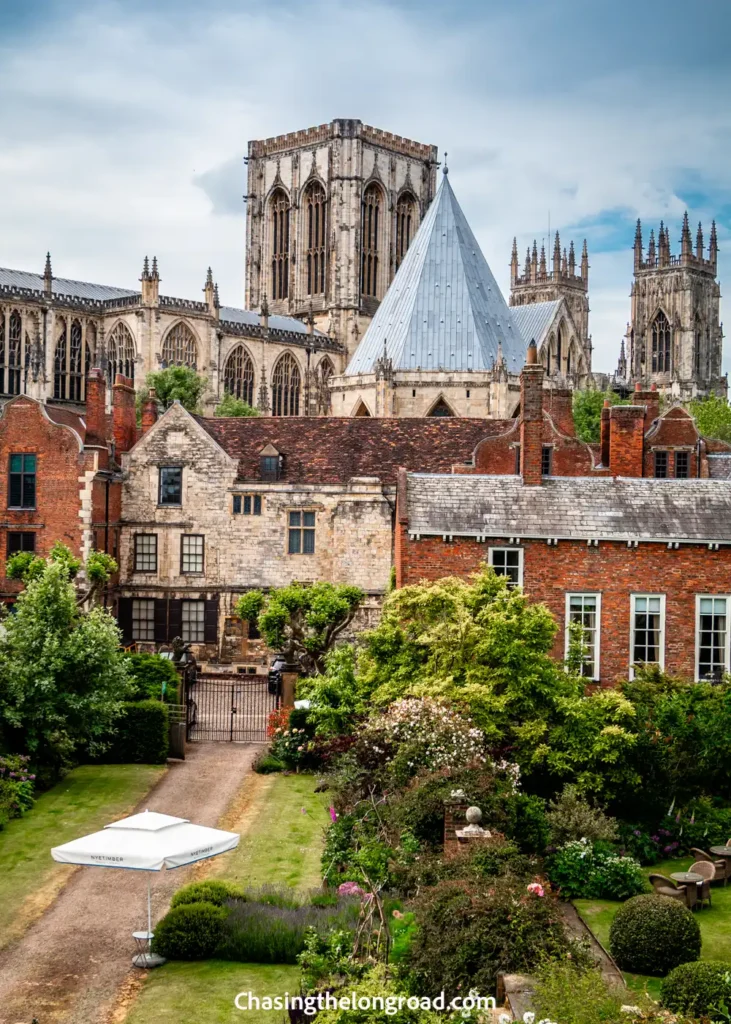If you are looking for some family-friendly activities to include in your York itinerary, the historic City Walls is just the right place for you.
This iconic Yorkshire landmark is one of the best well-preserved medieval walls in the whole of England.
The structure that we see today was mostly built around the 13th century. However, historians believe there was a wall here since the Roman times.
Today, this is a top tourist attraction in York. From keen wakers to photographers, there is something for everyone here.
Above all, exploring this historic monument doesn’t cost anything.

Along with the atmospheric Shambles and the beautiful Museum Gardens, the City Walls are the best free sites in York.
Walking the full circuit takes around two hours, depending on how often you stop to admire the views. Along the way, you will pass medieval towers, battlements, and peaceful greenery.
Plus, you can admire breathtaking elevated views of famous attractions, including York Minster, Clifford’s Tower, and the River Ouse.

The section from Bootham Bar to Monk Bar and the part near Barker Tower is our favourite.
This detailed guide will take you through each section of the City Walls, highlighting what to see, where to enter and exit, and practical advice for making the most of your visit.
A Brief History of the City Walls of York
Steeped in ancient history, the City Walls have withstood the test of time. It has protected the city from Viking settlers, Norman invaders and medieval battles.
They played an important role during the English Civil War in defending the city.
Throughout the centuries, the City Walls have gone through several transformations.
Its story began in AD 71 when the Romans established the city of York. Back then, they called it Eboracum. The first fortifications were built soon.

After the Roman withdrawal, this city came under the Viking rule in the 9th century. The walls served as a protective barrier for their thriving trade hub.
In the 12th and 13th centuries, York’s walls were rebuilt and expanded under the Normans.
They added many current sections of the walls, including the famous gatehouses or bars. These fortifications were meant to defend against Scottish invasions and local uprisings.
Today, the City Walls are a designated Scheduled Ancient Monument.
Practical Information for Visiting the York City Walls
1. It stretches for approximately 2 miles (3.4 kilometres), encircling the historic centre of York. It takes approximately two hours to complete the walk.
2. It is open to the public year-round, daily from 8 am till dusk.
3. Entry is free. However, if you are not willing to walk the entire trail, you can walk a short section of it.

4. York’s City Walls are broken up by four impressive gateways known as Bars. These gates once controlled traffic in and out of the city. Also, they were often used to collect tolls and defend the city during sieges.
5. There are several access points to the walls, usually near the bars. You can start or exit your walk at any point. Bootham Bar near York Minster and Micklegate Bar are good starting points.
6. While the pathways are generally safe, they can be narrow and uneven in places. Also, the surface might get slippery in rain or snow.

7. There are no facilities directly on the walls, but there are plenty of cafes, pubs, restaurants and shops near the gates.
8. Spring and summer are the best time to visit them. In spring, the ramparts are adorned with beautiful daffodils.
9. While most of the walls are accessible to walkers, there are many steps involved, and some sections may not be suitable for those with limited mobility.
10. Keep an eye on children, and take care when walking near the edges, as some sections don’t have railings.
A Walking Guide to the York City Walls
1. Bootham Bar to Monk Bar
Start your walking adventure from the historic Bootham Bar. This is one of the most scenic sections of the City Walls.
From here, you can admire the towering spires of the magnificent York Minster.
This section of the walls mainly dates back to the 11th century, but it includes parts of the original Roman walls. You will notice its distinct portcullis and the narrow turrets once used for defence purposes.

There are various cafes, pubs and restaurants nearby. Art enthusiasts can take a trip to the York Art Gallery, adjacent to the Bootham Bar entrance. It takes only 10 minutes to reach Monk Bar.
Constructed during the 14th century, Monk Bar is the tallest of the gates and once housed a self-contained apartment and a prison. It now holds a museum dedicated to Richard III, which was closed during our visit.
2. Monk Bar to Walmgate Bar
After leaving Monk Bar behind, the City Walls will lead you in the southeast direction, following the course of the River Foss.
Soon, you will reach Layerthorpe Bridge, a demolished gate that once controlled entry from the northeast. There is an information board detailing the history.
If you have time, take a short detour to visit the nearby St Anthony’s Garden, a tranquil hidden gem in York.

Continue along the riverside path to reach Red Tower, a small brick structure that once played a key role in the city’s defence. From here, follow the City Walls towards the historic Walmgate Bar.
A unique feature of Walmgate Bar is its barbican, the only surviving example of a town gate in England with its barbican intact. Today, it houses a quaint cafe inside.
3. Walmgate Bar to Micklegate Bar
Leaving behind Walmgate Bar, you will soon arrive at Fishergate Bar, another well-preserved medieval gate. It was heavily damaged during the 15th century but was rebuilt later in the Tudor period.
As you head toward Skeldergate Bridge, the beautiful River Ouse comes into view.

Soon, you will come across Baile Hill, a grassy mound that once held a Norman motte-and-bailey castle. Though the original wooden fort is long gone, the hill remains as a reminder of York’s Norman heritage.
Your next stop is Micklegate Bar, one of the most important gates in this city’s history.
Situated on the south side of the City Walls, Micklegate Bar served as the main ceremonial entrance for monarchs visiting York. Kings and queens used to pass through this gate when entering the city.
Also, this imposing structure has a gruesome past. The severed heads of traitors on spikes were displayed here.
4. Micklegate Bar to Bootham Bar
This final stretch takes you along the western walls back to the starting point at Bootham Bar.
As you continue along the stony path towards Barker Tower, you will be greeted with a gorgeous view of York Minster, the railway station and River Ouse.
Also, take some time to soak in the lovely vistas from the beautiful Lendal Bridge, spanning over the River Ouse. It is bustling with cruise boats, rowers, and picturesque riverside houses.
For the next part, visit the stunning York Museum Gardens. It is a peaceful spot to relax or enjoy a picnic.
Here, you can explore the stunning ruins of St. Mary’s Abbey and the Multangular Tower, a remnant of Roman fortress.
Map of the City Walls
Here is a map showing the various sections of the Walls. Also, we have marked all the main gateways. So, you can start the walk anywhere you prefer.
We hope this guide on exploring the gorgeous City Walls of York has inspired you to visit it during your next holiday.





Pingback: 30 Best Places to Visit in Yorkshire & Map
Pingback: A Guide to York Minster: England’s Gothic Masterpiece
Pingback: A Trip to York’s Chocolate Story